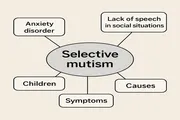

When we talk about an issue like selective mutism, we are essentially referring to a condition that affects school-age and adolescent children. It is in all respects a disorder linked to anxiety and fear that a child may feel in certain situations and contexts. Precisely because some of these situations cause a high level of anxiety, the child automatically stops speaking. The phenomenon manifests as a complete absence of verbal communication by the child when placed in a context that they perceive as anxiety-inducing or stressful. The term selective refers to a kind of internal filtering mechanism. The child will speak only to selected individuals, usually family members, and will have significant difficulty speaking in other environments such as school.
Is this condition a consequence of sensory or neurological problems? No, it is a block in communication that occurs due to an internal form of social anxiety. The behavior is not random—it is a clear avoidance strategy.
The child might be in a situation where there is a social expectation placed on them—like when teachers expect the child to speak and express opinions. In those moments, the child perceives pressure, or at least interprets it that way, because they believe the teachers are waiting for them to speak.
However, the child experiences unpleasant feelings that lead them to remain silent. Is it a widespread disorder among children or a rare condition? It is actually quite rare, with a prevalence of about one percent.
Is there a specific age when symptoms appear? Yes, around age two or three, early signs may include:
However, the problem becomes apparent around age five or six, typically in social contexts such as school. This is when verbal communication begins to be expected of the child.
Is this an easy disorder to diagnose? Not really. Due to its nature, diagnosis can be slow. Parents might not notice the issue until the child starts school.
In school, the need for interaction with peers and adults increases. Children are also expected to do classwork and homework, which may raise anxiety levels in those affected by this condition.
Over time, many studies have aimed to understand the disorder's development. Its name and classification in diagnostic manuals have changed. It was once believed to be intentional and was called elective mutism. It is now recognized as an anxiety-based disorder.
This reclassification has made it possible to define specific diagnostic criteria that help guide accurate diagnosis.
To diagnose selective mutism today, five key criteria are used:
Children with this condition may exhibit the following behaviors:
Children with selective mutism often communicate non-verbally. They might:
What factors influence the development of this disorder? Three main areas have been identified:
Children interact mainly in family and school settings. Collaboration between parents and teachers is crucial. Parents must avoid common mistakes—like pressuring the child to speak or speaking on their behalf in social situations.
Treatment is typically cognitive-behavioral therapy (CBT), aiming to:
Equally important is educating parents about the child’s condition so they can adopt supportive strategies at home.
Another common mistake parents make is substituting themselves for the child during verbal exchanges. For example, when someone asks the child a question, and the parent answers in their place. This reinforces avoidance behavior and can hinder progress.

For more information, visit the Wikipedia page on Selective Mutism.
It is a childhood anxiety disorder where the child stops speaking in certain social settings while speaking normally in familiar environments.
Early signs may appear around ages 2–3, but the disorder typically becomes evident at school age (5–6 years).
Persistent silence in specific contexts, neutral expressions, avoidance of eye contact, physical tension, and non-verbal communication strategies.
It requires consistent symptoms for at least one month, interference with social or academic functioning, and exclusion of language or neurological issues.
Cognitive-behavioral therapy (CBT) focused on reducing anxiety, improving self-esteem, and teaching emotional management skills. Parental involvement is key.